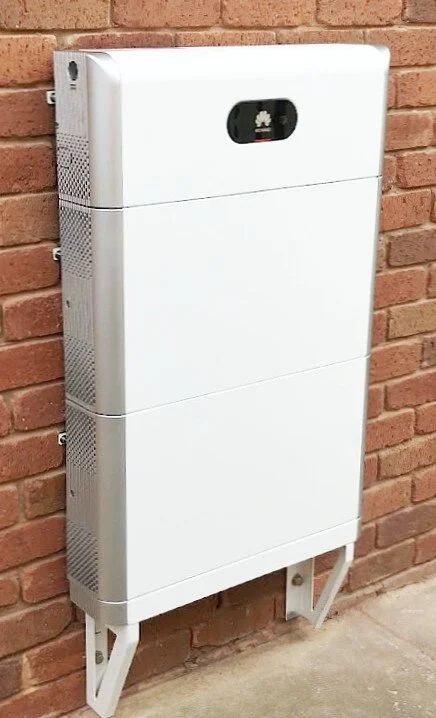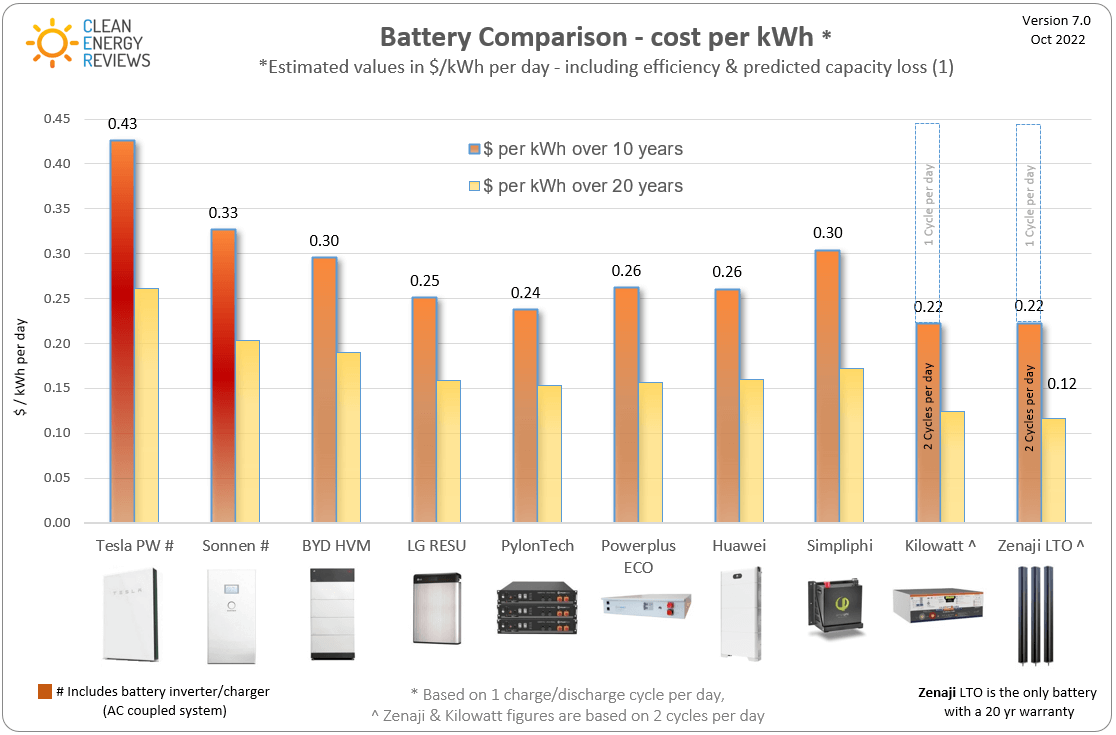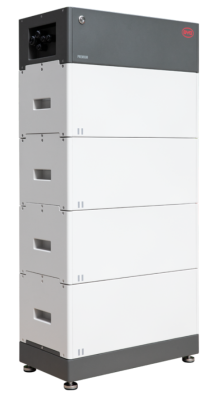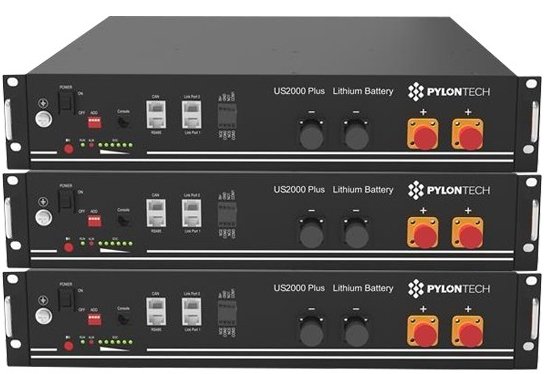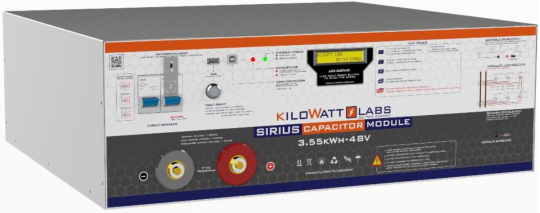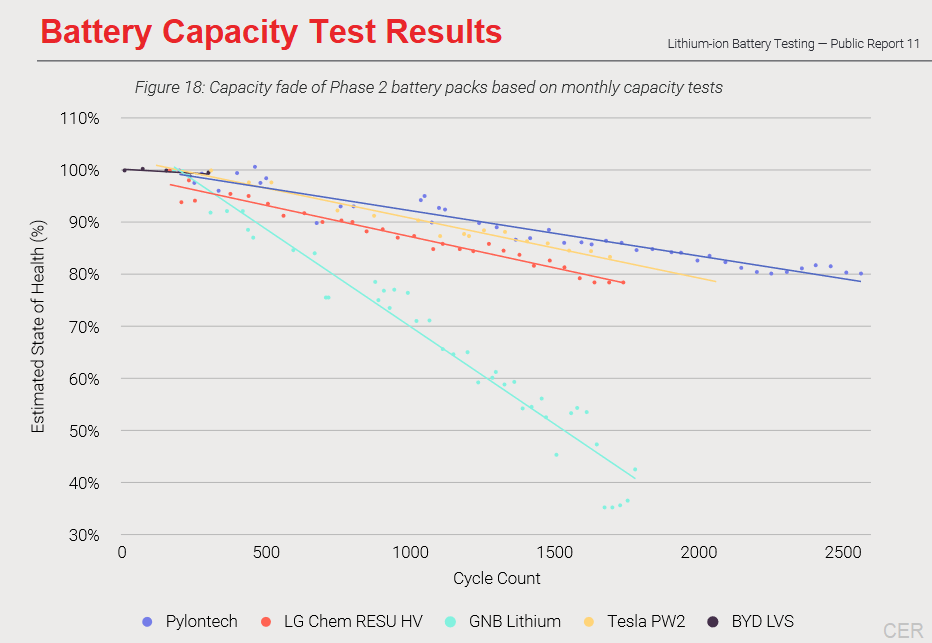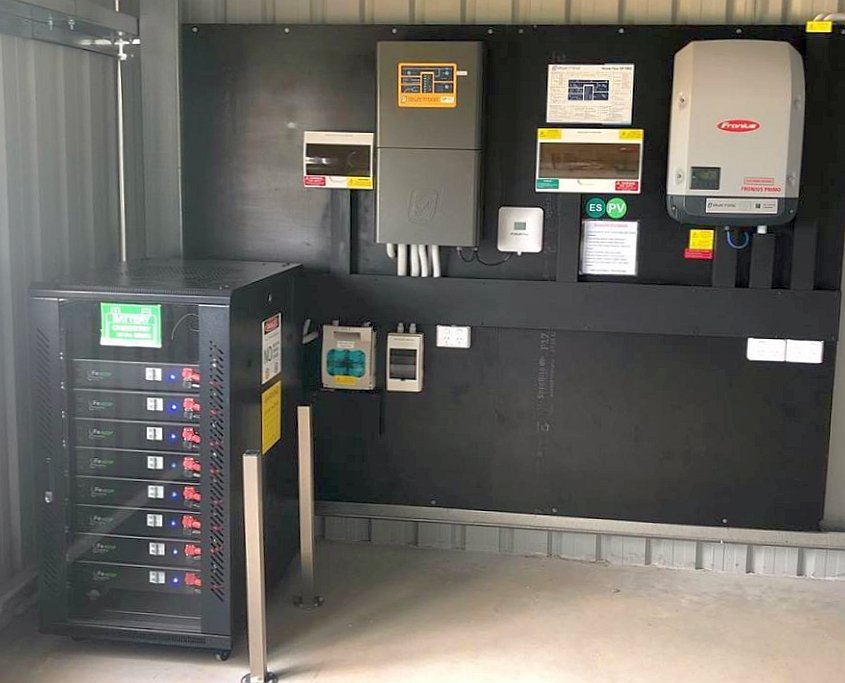Detailed Home Solar Battery Guide
This detailed battery storage review was first published in late 2015 and updated yearly to keep pace with the rapidly changing technology. See the entire revision history at the end of the article.
Background
The new Huawei LUNA2000 high voltage modular battery system installed
Home battery systems combined with rooftop solar have been touted as an energy revolution, a game-changer, or simply a way for people who are sick of paying high electricity prices to lower their bills. In Australia, there is an increasing incentive to store solar energy as the solar feed-in tariff (credit) has been reduced to as little as 5c per kWh. In comparison, the cost to purchase electricity is closer to 30c per kWh.
Batteries for energy storage in buildings have been around for a long time in both stand-alone (off-grid) and commercial backup (UPS) power systems. However, over the last few years, domestic energy storage in the form of hybrid solar systems has started to gain momentum, even with the relatively high cost of batteries. Another driving force for solar with battery storage is energy security. With increasing severe weather events due to climate change often causing prolonged power outages, a battery system can provide instant backup power for a home or business. Residential battery storage systems also enable energy independence and provide a means to generate and store your own renewable energy.
Home battery storage sizing - Want to know which solar battery is best suited to your home? See our detailed guide to selecting and sizing a home solar hybrid system.
Popular Battery Types
Traditional hybrid and off-grid solar systems used deep-cycle lead-acid batteries; however, over recent years, lithium batteries have taken over due to numerous advantages, including higher efficiency and longer warranties. While several new innovative battery technologies have been released over recent years, including sodium-ion and Redox flow batteries, the one clear winner regarding cost and efficiency is lithium-ion-based batteries. Hence, this article will focus on the proven and widely used lithium battery chemistries currently available, including:
Lithium iron phosphate - LiFePO4 or LFP - (Safest)
Lithium nickel manganese cobalt - NMC - (Fast charging)
Lithium titanate oxide - LTO - (Longest life)
The Battery Comparison
To make a comprehensive and accurate comparison of the leading lithium battery storage systems available, we lined up the most popular AC-coupled battery systems, the Tesla Powerwall 2 and Sonnen ECO, against a variety of DC-coupled batteries from some of the leading manufacturers including BYD and LG Energy, plus several popular lithium iron phosphate (LFP) battery systems used for off-grid and hybrid systems including Simpliphi, Australia’s PowerPlus Energy, and leading Chinese manufacturer’s BYD and PylonTech, along with the new Huawei LUNA2000 battery. To complete the review, we included two of the most talked about brands in recent years using lithium titanate cell technology, Australia’s Zenaji Aeon and the more contentious Sirus supercapacitor batteries from Kilowatt Labs.
Several new lithium battery technologies are emerging, as well as Sodium and Aluminium chemistries under development. However, these batteries are either not commercially available or have not reached the high-volume production levels required to become price-competitive.
Selected lithium batteries
Battery Details Comparison Table *
| Make | Cell type | Efficiency | Warranty | Cycle life (Warr*) | Cost per kWh |
|---|---|---|---|---|---|
| Sonnen ECO | Lithium LFP | 89% | 10 years | 4000 cycles | $1022 |
| Tesla Powerwall 2 | Lithium NMC | 89% | 10 years | 3700 cycles | $1194 |
| BYD HVM Premium | Lithium LFP | 93% | 10 years | 3600 cycles | $815 |
| LG Energy RESU | Lithium NMC | 93% | 10 years | 3600 cycles | $682 |
| PylonTech US3000 | Lithium LFP | 94% | 10 years | 3900 cycles | $660 |
| Powerplus Energy ECO | Lithium LFP | 94% | 10 years | 4000 cycles | $738 |
| Huawei Luna2000 | Lithium LFP | 95% | 10 years | 4000 cycles | $780 |
| Simpliphi Power PHI 3.8 | Lithium LFP | 96% | 10 years | 4000 cycles | $972 |
| Kilowatt Labs Sirius | Lithium LTO | 94% | 10 years | 10000 cycles | $1553 |
| Zenaji Aeon | Lithium LTO | 96% | 20 years | 22000 cycles | $1608 |
Comparison Tables notes:
Efficiency - Roundtrip efficiency or charging and discharging losses
Warranty - Manufacturers warranty period inc. allowable capacity loss over the warranty period
Cycle life Warranted* - based on warranty conditions and total energy throughput (1 cycle/day).
Cost per kWh - Upfront cost per kWh based on the usable capacity.
Results summary - Battery cost per kWh
Results Summary chart below - Battery cost comparison over a 10-year and 20-year period based on 1 or 2 cycles per day. Note that most batteries reviewed have a 10-year warranty, while the Zenaji Aeon LTO battery has an industry-leading 20-year warranty and almost unlimited cycle life.
Lead-acid Vs Lithium-ion Batteries
In the previous iterations of this article, we compared traditional lead-acid battery technologies against modern lithium systems using a number of criteria. A direct comparison was not easy as each battery chemistry behaves very differently under various conditions which can either prolong or decrease the life of the battery. The biggest differences were the dept of discharge available on a daily basis and the efficiency under high loads, operating conditions and temperatures. Read more about the difference between lithium and lead-acid (including Gel and AGM) using the image link below.
See the full details in our Lithium Vs Lead-acid battery article.
Battery Comparison Criteria
To accurately compare all the leading battery technologies and brands currently available we used several key criteria listed in order of importance below - Comparison criteria for smaller capacity hybrid and off-grid solar systems:
Price per kWh - Upfront cost and operational costs ($ per kWh per day)
Depth of discharge (DOD) – Usable energy
Cycle life - Number of charge cycles
Power output - Max continuous and peak power
Round trip efficiency - Charging and discharging losses
Sustainability - Environmental impact
Price per kWh
1. The first key criterion is the upfront price per kWh since the upfront cost is one of the most important aspects for many consumers. Next is the operational cost or battery cost per kWh over the life of the battery. This could also be described as the upfront cost amortised over the warranted life of the battery. Due to some battery chemistries having higher rates of degradation, the kWh cost per cycle is calculated based on the warranted capacity available after 10 years of use. We do this by calculating the cost per kWh per day assuming the battery is fully charged and discharged once a day over a 10 year period as this generally falls within the manufacturer’s warranty conditions.
Excluding the Lithium Titanate (LTO) batteries, cycling a lithium battery more than once a day will often mean the total energy throughput will fail outside the warranty specifications after 10 years, thus reducing the warranty period. For a clearer comparison, we have included both the 10-year and 20-year cycle costs per kWh for all batteries. However, based on the estimated cycle life, LFP and NMC lithium batteries would not be expected to last much longer than 15 years, while LTO batteries are expected to still be operational after 20 years. Note, the Zenaji battery is the only option with almost unlimited cycles backed by an industry-leading 20-year warranty.
Depth of discharge and cycle life
2 - 3. The second and third criteria really go hand in hand as battery life is almost always directly proportional to the depth of discharge (DOD). This means that the further a battery is discharged the shorter the battery life. The available energy or DOD on a daily cycle (charged and discharged every day) is usually specified by the manufacturer and the cycle life in years is based on this DOD value. However, the end of life (EOL) of a battery is not always clear as a battery doesn't just suddenly stop working after a certain number of cycles. Almost all battery technologies new and old slowly lose capacity over time and the industry standard for Lead-acid is to determine the EOL once battery capacity has dropped to 80%. However, more recent lithium manufacturers such as LG and Tesla are warranting their batteries to lower EOL values of 60 or 70%. Remember, a battery is still generally usable after this, they just don't store as much energy.
To complicate this further, in real-world conditions, there are many variables, including temperature, rate of discharge and incomplete charge (partial state of charge), so the performance and life of a battery system can be significantly altered.
As a general guide, lithium-based batteries are designed to be discharged up to 90% of total capacity, while the traditional lead-acid (gel & AGM) batteries are generally not discharged lower than 60% SOC unless in emergency backup situations. For those who work in the industry, this is a relatively standard presumption.
Battery Power Output
4. Following this, we have the continuous and peak power output. This can be very important depending on the type of inverter you are using and the application. For example, off-grid installations will usually require a higher peak power output as you do not have the grid available to assist in high-load (high power draw) situations.
Round Trip Efficiency
5. Next is round trip efficiency, which is the charging and discharging efficiency or losses during cycle use. Unfortunately, due to the laws of physics, the transfer of energy from one form to another (in the case of batteries from electrical to chemical energy) will always result in some losses. Generally, charge/discharge losses from a lead-acid-based battery are close to 20%, while most lithium-ion batteries can be as low as 2% but generally operate in the 5-8% range.
Sustainability - Environmental impact
6. Of course, there are other important factors that should be considered, such as recyclability, temperature tolerance and safety. Sustainability will become increasingly important as more and more battery systems are installed. Plus, recyclability will, over time, become a major issue. This topic is covered in detail towards the end of this review.
Battery Specifications
SonnenBatterie ECO
Sonnen is a leading German lithium battery manufacturer and is the largest residential lithium battery system company in Europe. Until recently, Sonnen had deployed the largest amount of home battery systems globally surpassing Tesla and LG. The SonnenBatterie ECO range is much like the Tesla Powerwall 2 in that it is an AC battery with a built-in inverter-charger, however, like the Powerwall, it still requires an additional solar inverter to function with a solar array. The Sonnen ECO contains a modular battery system built on 2.5kWh lithium iron phosphate modules supplied by PylonTech or Sony.
See the full specifications, life cycle, warranty and costing details here.
Tesla Powerwall
The Tesla Powerwall with 13.5kWh of 'usable' storage capacity is an AC battery that features an integrated 5kW DC-AC inverter/charger and an advanced liquid thermal management system. AC batteries are stand-alone battery systems that can be fitted to any home with an existing solar installation. This can make installation simpler, but it still requires a solar inverter to function with a solar array, plus the additional Tesla gateway box is required to enable backup power in the event of a power outage.
See the specifications, life cycle, warranty and costing details comparison here.
See the detailed Tesla Powerwall 2 review
LG Chem RESU
LG Chem offers a much larger range of RESU (Residential Energy Storage Unit) batteries in various sizes from 3.3kWh up to 9.8kWh in two voltage options, 48V and 400V. Previously just the single 6.4kWh RESU6.4EX lithium battery was available. The latest 48V range includes RESU3.3, RESU6.5 and RESU10 units with an option to combine different units using an adapter for up to 19.6kWh of total storage.
See the specifications, life cycle, warranty and costing details comparison here.
See the detailed LG RESU battery review
BYD HVM Premium
BYD is the largest Chinese manufacturer of rechargeable lithium batteries and has dominated the Chinese electric vehicle and energy storage market for some time. The new HVM or high-voltage range is the third generation modular stackable battery from BYD. The company manufactures a wide range of lithium energy storage systems for both commercial and residential applications using only LFP or Lithium Ferro Phosphate cells which are considered the safest and most stable battery chemistry.
Apart from the high-voltage HVM series, BYD also produces a range of low-voltage (48V) modules for residential hybrid and off-grid installations.
See the detailed BYD battery review
PylonTech US3000
The Pylon Technologies lithium iron phosphate (LiFePO4 or LFP) batteries were some of the first modular lithium-based batteries available which enclosed both the lithium cells and battery management/control system in a simple rack-mounted unit. They are available in 2.4kWh (US2000) and 3.55kWh (US3000) sizes and allow easy set-up together with connections for multiple units in parallel. PylonTech also produces large scale high-voltage battery systems for commercial and utility-scale applications.
See the specifications, life cycle, warranty and costing details comparison here.
See the detailed Pylontech battery review
Powerplus Energy ECO
Powerplus Energy is one of the leading Australian battery manufacturers and has developed a range of modular, scalable rack-mount batteries designed for both on-grid and off-grid applications. LFP cells are used in all of the Powerplus batteries due to the longer lifespan, increased safety and reliability. Powerplus offer a range of LiFe Premium or ECO batteries, but for this particular review, we chose the more cost-effective ECO P-series 48V 4kWh modules which are one of the most popular batteries currently available.
Huawei LUNA2000
Huawei is one of the worlds largest solar inverter manufacturers and the company recently released a unique modular high-voltage battery system designed to be used with the Huawei hybrid inverters for residential energy storage and backup power. Unlike most other modular high-voltage battery systems which are connected in series, such as those from BYD and Sungrow, the individual 5kWh Huawei HV modules are all connected in parallel and can essentially operate independently, meaning of one of the modules is at a lower voltage or state of charge then it will not cause an imbalance in the system. This is similar to how many of the 48V rack-mount batteries operate.
See the detailed Huawei LUNA2000 battery review
Simpliphi PHI
Simpliphi Power is a US-based battery manufacturer which has been a leading developer of Lithium-ion batteries since 2002. Initially developed for durable remote military and mobile power systems the Simpliphi PHI batteries used LFP cells and are well known for their high cycle life, safety and stability. The latest iteration is the 48V PHI 3.8kWh battery which is slightly larger than the previous 3.5kWh version used in this review.
See the SimpliPhi specifications, life cycle, warranty and costing details comparison here.
Kilowatt Labs SIRIUS
The SIRIUS capacitor modules from Kilowatt labs in Israel created quite a stir when they were initially released in 2017 as they were found to contain relatively common Lithium Titanate (LTO) cells based on the many independent tests conducted and were not built on a unique capacitor technology as the name suggests. However, despite the name, LTO cells are extremely powerful and boast characteristics such as rapid charging which are similar in performance to capacitors. LTO cells are also known to be the longest-lasting and most durable lithium chemistry. Kilowatt Labs now manufacture a wide range of 48V self-managed batteries for residential, commercial and utility applications.
Zenaji Aeon
The unique Australian made Zenaji Aeon Batteries boast the highest lifespan on the market and are backed by a 20-year warranty, 10 years longer than the industry standard. This is not surprising as the batteries are built using Lithium Titanate (LTO) cells which are the longest-lasting lithium cells available and are able to be rapidly charged and discharged at rates far higher than common LFP and NMC cells used by most other manufacturers.
Lithium Titanate is more expensive so the high performance and longer lifespan of the Zenaji LTO cells come at a significantly higher cost. However, as highlighted by our cost per kWh comparison charts, the much greater cycle life of LTO batteries mean the Zenaji batteries can be charged or cycled multiple times per day without any significant degradation or loss of capacity, even after 20+ years of use.
Battery Cost Comparison Charts
Chart showing Upfront Cost per kWh - usable capacity
Battery upfront cost per kWh comparison chart in Australian dollars - US dollar conversion shown
ITP Renewables Lithium Battery Test Centre
ITP Renewables in Canberra Australia have been running battery performance tests at the Canberra Institute of Technology since 2016. The tests are performed in a climate controlled environment to simulate real world conditions in an accelerated manner. The tests have had some very interesting results over the years but due to some issues with hardware and monitoring the early results were not 100% reliable. The centre is testing many of the worlds leading stationary battery systems including several of the batteries in this review. The results are published every 6 months and will be vital to determining the life and performance of various home energy storage batteries in simulated real world conditions. We look forward to the next set of results published.
The latest ITP renewables battery test centre results - See the latest ITP battery test center results here.
Conclusion
Based purely on the cost per kWh over a 10 year period, the PylonTech, LG, PowerPlus and Huawei batteries all come in below 26c per kWh based on one cycle per day. However, it is clear that the Kilowatt Labs and Zenaji batteries beat the others with a cost of 22c per kWh. Although, it is important to note that this is only the case when the figures are calculated based on two charge cycles per day and assume the batteries are charged using both solar and low-cost off-peak electricity. Unlike the LFP and NMC battery systems, the LTO cells used by Kilowatt Labs and Zenaji can be cycled multiple times per day without any significant degradation or loss of capacity.
Beyond ten years, the Zenaji Aeon batteries will no doubt outlast the competition due to the longer life LTO chemistry backed up by an industry-leading 20-year warranty. Generally, LFP batteries, if managed correctly, will result in slightly lower capacity loss and longer life compared to NMC batteries, so long as charge/discharge rates are maintained as specified. However, BYD and PylonTech LFP batteries are expected to have a greater loss of capacity over time due to the very high discharge and charge rates allowed, which can accelerate degradation. Interestingly, based on the accelerated testing at ITP renewables, the older BYD batteries showed significant degradation, while the PylonTech batteries have performed extremely well.
The Sonnen ECO and Tesla Powerwall 2 are the only batteries that come with an integrated inverter and can be AC-coupled with an existing solar system. All the other batteries in this review must be installed together with a compatible hybrid or off-grid inverter, which will add to the upfront installation cost and the cost per kWh operating figures. The recent price increases from Tesla pushed the Powerwall 2 operating cost well above all other brands, although the Powerwall is still the only battery with a liquid cooling system in addition to the built-in battery inverter.
It is important to note there are several assumptions used, and true performance in real-world conditions may vary. Also, this comparison is focused on smaller capacity (hybrid) systems used for residential applications of less than 20kWh capacity.
Battery Power Output comparison
Battery continuous and peak power output comparison chart
The continuous power output of some lithium batteries including LG, Sonnen and Huawei are somewhat limited to the amount shown in the above chart despite how many battery modules are added. Although with most other brands shown here, multiple battery modules can be linked together in parallel to provide greater power output. The SimpliPhi, Powerplus, BYD, Kilowatt and Zenaji batteries are all fully scalable and can provide greater power with more batteries, however, they will be limited by the inverter used to operate the battery system. For most residential applications, the 5kW continuous output of the Tesla and LG batteries is more than adequate.
Generally for higher capacity battery systems (above 20kWh) and high power output systems above 5kW then SimpliPhi, BYD, Pylontech, or Powerplus would be the best option. If high surge power or fast charging is required, then the Kilowatt Labs or Zenaji LTO batteries are by far the best choice. The Sonnen ECO range is rather limited when it comes to power output as the maximum is 3.3kW continuous output due to the fixed inverter size.
Battery Efficiency
Battery round trip efficiency comparison chart
The round trip efficiency is the charging and discharging efficiency or losses during use. Unfortunately due to the laws of physics the transfer of energy from one form to another results in some losses and in the case of lead-acid, this is normally as high as 20%. The modern lithium batteries can achieve extremely high efficiency with as low as 2% losses, which over time means the performance and return on investment is much greater.
Inverter Compatibility
Besides the cost per kWh figure, there are many important factors to consider when selecting a battery storage system such as compatibility with the hybrid or off-grid inverter and adaptability with your existing solar setup (if installed). The Powerwall 2 and Sonnen ECO being AC-coupled batteries are very flexible and can be added to most new or existing solar systems regardless of the exister solar inverter model or brand.
The LG RESU, PylonTech and BYD batteries are ‘managed’ DC-coupled battery systems and are compatible with many of the well-known hybrid inverters. LG RESU 48V batteries are compatible with many of the leading hybrid & off-grid inverter brands including Selectronic, Solax, Sungrow, Schneider Electric, GoodWe, Redback and Victron Energy. The BYD range of high-voltage and low-voltage batteries are also compatible with a large number of hybrid and off-grid inverters including Victron, Fronius, SMA, Solax, Selectronic, and Goodwe.
PylonTech is also compatible with many leading hybrid inverters, including Redback, Solax, Victron and Imeon. For this reason, it is recommended to use a hybrid kit (battery and inverter combo) known to be compatible. Some examples are:
Redback Technologies and PylonTech
Selectronic SP PRO and Powerplus, BYD, PylonTech, Zenaji or SimpliPhi
SMA Sunny Island and LG, BYD, or SimpliPhi
Victron Energy and PylonTech, Powerplus, BYD, GenZ, or SimpliPhi PHI
Lithium Batteries for Off-grid systems
An off-grid solar system using a modular ‘self-managed’ lithium battery bank. Full details in the off-grid solar system review.
The US-made SimpliPhi PHI and Australian GenZ or PowerPlus Energy lithium LFP batteries are self-managed and are some of the few 'drop-in' replacement lithium batteries that can operate with the leading off-grid inverters. The self-managed lithium titanate batteries from Zenaji and Kilowatt labs can also work well in off-grid systems but the inverter has to be compatible with the wider operating voltage range of these specific batteries. All these various self-managed scalable batteries are able to be easily linked up to provide adequate storage capacity and continuous/peak power output for larger off-grid systems from 10kWh to 200kWh or more.
The Tesla Powerwall 2 and Sonnen ECO AC battery systems are not specifically designed for off-grid use as the in-built (transformerless) inverters are not capable of handling very high surge loads and do not incorporate any backup (black-start) features. However, the Tesla Powerwall 2 is certified for off-grid use when at least 2 Powerwall units are installed in parallel.
From our knowledge, the SimpliPhi PHI, GenZ, PowerPlus Energy, Kilowatt Labs Sirius, and Zenaji Aeon are the only lithium batteries certified for off-grid installations when used with a high-end off-grid inverter such as the Selectronic SP PRO. For more information, see our technical guide to selecting an off-grid or hybrid inverter.
Note: Some off-grid inverters are optimised for charging lead-acid batteries, and some lack the required communications (CANbus) to monitor a lithium battery management system (BMS). This is where the self-managed lithium batteries are a real bonus as long as the battery inverter-charger settings can be adjusted to suit the lithium battery charging parameters.
Also, see our best off-grid solar systems review for more detailed off-grid battery details.
Battery Recycling and Sustainability
With an ever-increasing number of battery installations around the world comes the inevitable problem of recycling the batteries once they have reached the end of their usable life. In the case of lead-acid based batteries, this is not an issue as the infrastructure and recycling collection centres are already in place in most countries, enabling the Lead, plastic and electrolyte to be extracted and recycled relatively easily. In fact, approximately 96% of all lead-acid batteries are recycled.
Lithium batteries are more difficult to recycle. However there have been several breakthroughs in recent years by various groups which are developing advanced recycling techniques specifically for complex lithium-based batteries. There is a new emerging battery recycling industry in Australia which is outlined in this article. In North America, American Manganese Inc is one of the many companies developing lithium battery recycling facilities around the world. There are also some unique battery recycling methods being developed to simply extract the compounds (battery elements) to be manufactured into new batteries.
In Australia, the leading scientific organisation CSIRO is working on developing new and innovative processes for the recovery of metals from old batteries to be re-used in the manufacture of new batteries as well as the development of new battery technology which is able to be easily recycled. Read more about the work at CSIRO here.
Of all the lithium battery chemistries available the Lithium Iron Phosphate (LFP) batteries are the least toxic as they do not contain Cobalt. LFP batteries are also considered the safest chemistry with the longest life and lowest risk of thermal runaway if damaged or overheated.
Re-using old electric vehicle batteries in homes
In the case of electric vehicles, the Australian startup Relectrify has developed a clever way to extend the life of EV batteries by re-assembling them into a stationary unit for use in homes and businesses. Since most EV batteries still have a retained capacity of 60% or more at the end of life, this will give a new life to old lithium batteries for an additional decade or more extended use.
Since most lithium batteries used for energy storage are still in use there is no real push on recycling until the batteries reach their end of life over the next 5-10 years. The recycling difficulties lie in the complex lithium chemistries being manufactured of which there are several variations. Some cells are in powder form, others coated onto metal foil, all of which must be separated. At present, the safest Lithium combination is lithium iron phosphate (LiFePO4 or LFP for short) which is one of the lithium batteries which can be more easily recycled. Lithium cells are also much smaller and often incorporate electronic management systems and thermal sensors which will also need to be disassembled. There is still abundant quantities of lithium minerals available but it is a finite resource so this will lead to greater incentives to develop more ways to recycle lithium batteries as the raw material cost will no doubt rise as demand increases.
Revision history
This article was first published in Nov 2015, with the subsequent updates below.
Update 1 - May 2016 - price reductions and specification changes
Update 2 - Aug 2016 - Powerwall 1 warranty and LG chem spec update. Cost per kWh comparison now includes battery efficiency.
Update 3 - Oct 2016 - New LG chem RESU, new pricing and warranty.
Update 4 - Nov 2016 - Tesla Powerwall 2 announced, double capacity.
Update 5 - Feb 2017 - Powerwall 2 pricing and specifications
Update 6 - Mar 2017 - New PylonTech battery model US2000, was Extra2000
Update 7 - May 2018 - Price updates (Tesla & LG) Added Simpliphi and Sonnen.
Update 8 - Jun 2018 - Added battery capacity loss over lifetime. Updated battery efficiency specs including inverter losses.
Update 9 - Nov 2018 - LG price drop & Tesla price increase. Added BYD battery.
Update 10 - Aug 2019 - Price adjustments and updated charts.
Update 11 - Oct 2019 - ITP test centre results used to estimate and adjust battery life.
Update 12 - Nov 2020 - Price adjustments and updated charts.
Update 13 - Aug 2021 - Removed lead-acid batteries. Added Powerplus ECO, Huawei, Kilowatt Lab’s supercapacitor, Zenaji Aeon LTO. Updated BYD and PylonTech batteries.
Update 14 - Oct 2022 - Updated pricing, in particular the considerable Tesla Powerwall price increases throughout 2022.


